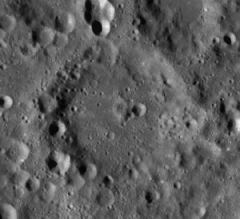Vernadskiy (crater)
Vernadskiy is a lunar impact crater on the far side of the Moon, behind the visible eastern limb. It lies to the west-northwest of the smaller crater Siedentopf. To the south is Gavrilov, and much farther to the west is Meggers.
 LRO image | |
| Coordinates | 23.2°N 130.5°E |
|---|---|
| Diameter | 91 km |
| Depth | Unknown |
| Colongitude | 230° at sunrise |
| Eponym | Vladimir I. Vernadsky |
This is a formation that has seen better days. The outer rim has been bombarded by a myriad of lesser impacts, producing an eroded and irregular edge. Attached to the outer rim to the northeast is the crater Florensky, an equally worn crater. The interior floor of Vernadskiy is also marked by a number of small impacts, although in general it is more level than the uneven terrain that surrounds the crater.
In some sources the name is spelled as Vernadskyy, Vernadskij, or Vernadsky. The spelling followed in this article is that adopted by the IAU in 1970.[1] The crater is named in honour of Vladimir Vernadsky, a Soviet mineralogist.
Satellite craters
By convention these features are identified on lunar maps by placing the letter on the side of the crater midpoint that is closest to Vernadskiy.
| Vernadskiy | Latitude | Longitude | Diameter |
|---|---|---|---|
| U | 23.7° N | 126.5° E | 37 km |
| X | 25.9° N | 129.0° E | 64 km |
Vernadskiy B - see Florensky
References
- Vernadskiy Gazetteer of Planetary Nomenclature, International Astronomical Union (IAU) Working Group for Planetary System Nomenclature (WGPSN)
- Andersson, L. E.; Whitaker, E. A. (1982). NASA Catalogue of Lunar Nomenclature. NASA RP-1097.CS1 maint: ref=harv (link)
- Blue, Jennifer (July 25, 2007). "Gazetteer of Planetary Nomenclature". USGS. Retrieved 2007-08-05.CS1 maint: ref=harv (link)
- Bussey, B.; Spudis, P. (2004). The Clementine Atlas of the Moon. New York: Cambridge University Press. ISBN 978-0-521-81528-4.CS1 maint: ref=harv (link)
- Cocks, Elijah E.; Cocks, Josiah C. (1995). Who's Who on the Moon: A Biographical Dictionary of Lunar Nomenclature. Tudor Publishers. ISBN 978-0-936389-27-1.CS1 maint: ref=harv (link)
- McDowell, Jonathan (July 15, 2007). "Lunar Nomenclature". Jonathan's Space Report. Retrieved 2007-10-24.CS1 maint: ref=harv (link)
- Menzel, D. H.; Minnaert, M.; Levin, B.; Dollfus, A.; Bell, B. (1971). "Report on Lunar Nomenclature by the Working Group of Commission 17 of the IAU". Space Science Reviews. 12 (2): 136–186. Bibcode:1971SSRv...12..136M. doi:10.1007/BF00171763.CS1 maint: ref=harv (link)
- Moore, Patrick (2001). On the Moon. Sterling Publishing Co. ISBN 978-0-304-35469-6.CS1 maint: ref=harv (link)
- Price, Fred W. (1988). The Moon Observer's Handbook. Cambridge University Press. ISBN 978-0-521-33500-3.CS1 maint: ref=harv (link)
- Rükl, Antonín (1990). Atlas of the Moon. Kalmbach Books. ISBN 978-0-913135-17-4.CS1 maint: ref=harv (link)
- Webb, Rev. T. W. (1962). Celestial Objects for Common Telescopes (6th revised ed.). Dover. ISBN 978-0-486-20917-3.CS1 maint: ref=harv (link)
- Whitaker, Ewen A. (1999). Mapping and Naming the Moon. Cambridge University Press. ISBN 978-0-521-62248-6.CS1 maint: ref=harv (link)
- Wlasuk, Peter T. (2000). Observing the Moon. Springer. ISBN 978-1-85233-193-1.CS1 maint: ref=harv (link)